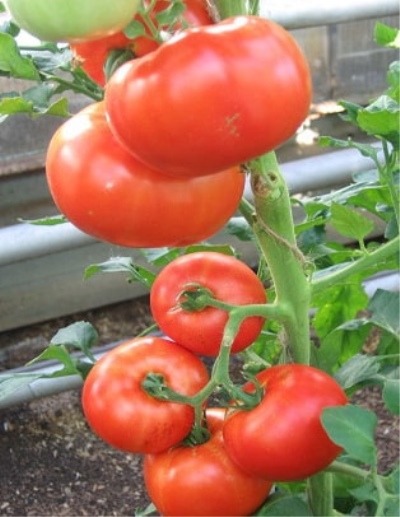
- Authors: Motov Viktor Mikhailovich, NPF "Agrosemtoms" LLC
- Year of approval: 2005
- Category: hybrid
- Growth type: semi-determinant
- Ripening period: early
- Ripening time, days: 108-115
- Growing conditions: for open ground, for closed ground
- Marketability: high
- Transportability: transportable
- Marketable fruit yield,%: 91
Baron tomatoes can become a faithful companion for many gardeners. It will only be necessary to thoroughly study their features and nuances of cultivation. Both the planting scheme and the real yield deserve attention.
Breeding history
Tomato Baron was created by the specialists of NPF "Agrosemtoms". The main selection work was coordinated and carried out by V.M. Motov. The culture was allowed to be used in 2005. This is a typical hybrid plant.
Description of the variety
The plant is suitable for both open and closed ground. The share of marketable fruits is 91%. Bushes develop in a semi-determinate manner. An important characteristic feature is the pronounced foliage. Individual leaves are large and have a simple green color.
The main qualities of the fruit
Baron's unripe berries are light green in color. When they ripen, they turn pure red, like many other tomatoes. Their mass can range from 122 to 134 g. In flat-round berries, a distinctly pointed tip is found. The inflorescence is arranged in a simple manner; the first of them will be laid over the 9th leaf, the next - after 1-2 sheets.
Taste characteristics
Baron's taste is quite good, according to most consumers. Its flesh is quite fleshy. The crop is used fresh. If necessary, it can be processed or preserved.
Ripening and fruiting
The variety belongs to the early group. You can wait for the berries to appear in 108-115 days. They usually start filming at the end of August. Fruiting in a typical year also covers September. We must also add a decent keeping quality of "aristocratic" tomatoes.
Yield
The collection can be at least 13.8 kg per 1 sq. m. Under favorable conditions, this figure reaches 16.6 kg. According to other sources, fertility can range from 15 to 18 kg per 1 m2. The exact figure depends not only on the weather, but also on the planting density.
The timing of planting seedlings and planting in the ground
Seeds can be used in the second half of March or in the first April decade. Transplantation into open ground is carried out only after the firm completion of return frosts. In the Non-Black Earth Region, this is usually June 5-10. But greenhouse growing of bushes can be started already at the end of April.

Growing tomato seedlings is an extremely important process, because it largely depends on whether the gardener can harvest at all. All aspects must be taken into account, from seedbed preparation to planting in the ground.
Landing scheme
3 or 4 seedlings are placed on 1 "square". In a number of sources, this number has been increased to 6-8 plants. The specific option depends on the formation and preferences of farmers. Mostly they are guided by the norm of 500x400 mm.

Growing and care
In the evenings the Baron needs to be watered. For this, only warm water is used.Ventilation is critical in greenhouses: it helps to stabilize humidity and prevent overheating. Loosening or mulching the land relies on throughout the growing season. As soon as the bush picks up fruit weight, a garter is advisable.




A plant needs different micronutrients at each stage of growth. All fertilizers can be divided into two groups: mineral and organic. Folk remedies are often used: iodine, yeast, bird droppings, eggshells.
It is important to observe the rate and period of feeding. This also applies to folk remedies and organic fertilizers.
Disease and pest resistance
The variety is resistant to:
cladosporium disease;
verticillosis;
the tobacco mosaic virus.


Resistant to adverse weather conditions
Poor meteorological conditions Baron does not care. Moreover, it also perfectly survives even weather fluctuations.
Growing regions
The Baron is zoned for the Central Black Earth Agrarian Region. Therefore, it can be safely planted in the vicinity of Kursk, Voronezh and Tambov. And also there is an official admission for growing in central Russia.
Review overview
Summer residents speak enthusiastically about the Baron. Ease of maintenance is often mentioned in comparison to other varieties. Even low germination of seeds in a number of deliveries does not spoil the impression. Often indicate the visual grace and strength of the fruit, the absence of diseases. In general, this hybrid performs better than most varietal specimens.

























































































